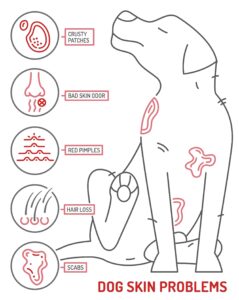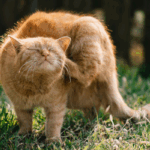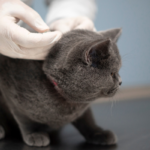“Hot Spots” in our canine patients, can come up very quickly ( a matter of hours), but it can take days (or even weeks) to clear up. They also have a good reputation for coming back too.
Hot Spots will always recur when the underlying cause is not identified, and the perpetuating agents (bacteria) are not controlled.
Hot spots are often given the name of Acute Pyotraumatic dermatitis or Acute Moist Pyoderma – but Hot spot describes it best – it is a red round sore with yellow ooze (pus), which mats the fur together – and it is painful to touch, but the dog can’t stop themselves from scratching, licking or biting it. Cats can get hot spots too – the treatment is similar, but the causes are different.
First of all – how to recognise a “Hot Spot”
- it is acute – it comes up very quickly
- it is red, round or oval shaped sore with matted fur, sometimes with a yellow ooze (which is pus)
- hairloss is common, and a feature is an intense itchiness
A vet visit is always necessary, as the challenge comes in not actually diagnosing or treating the Hot Spot, but to determine why it occurred – that is, looking at it like a sign of disease, other than a diagnosis in its own right. Virtually all pets need more aggressive therapies than what is available in most households.
How can you treat “Hot Spots” at home?
The principles of treatment are fairly straightforward –
– the lesion is wet – the moisture traps infection – so you need to dry it out
– the lesion is itchy – we need to stop the pet accessing the sore
– the lesion is being perpetuated – stimulated to continue either through the weather (humidity is a factor) or bacterial overgrowth of the skin alone.
If at any time you think your pet may hurt you in trying to treat this at home, do not persist – never underestimate how painful these sores are. We don’t. We often need to sedate or anaesthetise patients to get them cleaned up properly.
The first thing is – Clip up the area, using clippers or scissors. Clip to the area beyond the redness – you need to be able to see normal skin
Next – using an antibacterial wash (we suggest 3% chlorhexidine veterinary quality shampoos) – gently wash/soak the sore. Leave it on for 10 minutes. Rinse very very well. As an alternative, you can use Betadine, but only for a maximum of two days – whilst it had antibacterial effects, it can also delay healing, which we do not want.
Dr Liz’s tips : The correct method of washing your pet with medicated shampoos.
Next – Pat dry with a towel or gauze swabs. (this deals with the wet part and the bacterial overgrowth part of the problem).
The next part depends on what you have at home, or what you are able to get your hands on without a veterinary prescription. We now nee
d to settle down the itching, and stop the itch-scratch cycle, knowing full well that in the majority of cases, it is due to an underlying allergic skin disease(whether it be biting flies, mosquitoes, fleas, food or grasses/pollens).
It also depends on where the hot spot is – if it is on the head or butt – an Elizabethan collar may help. If it is somewhere else, and a foot can get to it, then a sock on the foot may help.
As for ointments and creams – your pet really needs a topical anti-anflammatory and anti-bacterial cream – the ones we use are by prescription only. But in an emergency, out of normal hours – what can you use? Until you can get into a vet, we suggest a 0.5% to 1% hydrocortisone cream that should be available over the counter at the chemist, but you cannot use this any more than twice on the sore, as you really need the combination ointment. You need to find one that you can use on open skin (check with the pharmacist).

What can we do at Russell Vale Animal Clinic –
As your pet is in pain, we use medications to sedate them to allow us to clip and clean the sore properly. Some pets are so stoic and brave, that we may use lots of huggles and liver treats instead to allow us to clip up the sore. Some pets benefit from systemic medications of antibiotics and anti-inflammatories, as well as the topical treatments.
What we always do is discuss with you the “why” it happened, to determine on how to prevent recurrence.
Hot Spots will always recur when the underlying cause is not identified, and the perpetuating agents (bacteria) are not controlled.
What not to use
- Do not use Dettol or Savlon creams or lotions (animal bacteria can multiple in these ointments – you are just feeding the bacteria rather than killing them)
- Do not use Tea tree oil or any equivalents (they don’t work – scientific tests show that sores get better inspite of, rather than because of these types of things) and definitely do not use Wool wash – Dogs and cats have fur not wool!
- Do not use alcohol (it stings) or Mercurochrome (it doesn’t really dry out the sore, it just turns your pet into one with pink splotches, and makes it harder to see how the hot spot is healing.
- Do not use salty water if the hair has not been trimmed off
- Hair dryers or water that is too hot or cold (makes things worse)
- Do not use oatmeal based shampoos or conditioners (they have no antibacterial function at all).
Do not use human shampoos or conditioners without veterinary advice
I am Dr Liz, known as the “Mad Vet of Bellambi”. This was written by me, nothing artificial about my intelligence, and it is an update of the blog post published on 9/23/13 9:42 PM on a blogger site.




